A haven for wildlife and a paradise for photographers. Drew Buckley reports from Skomer Island
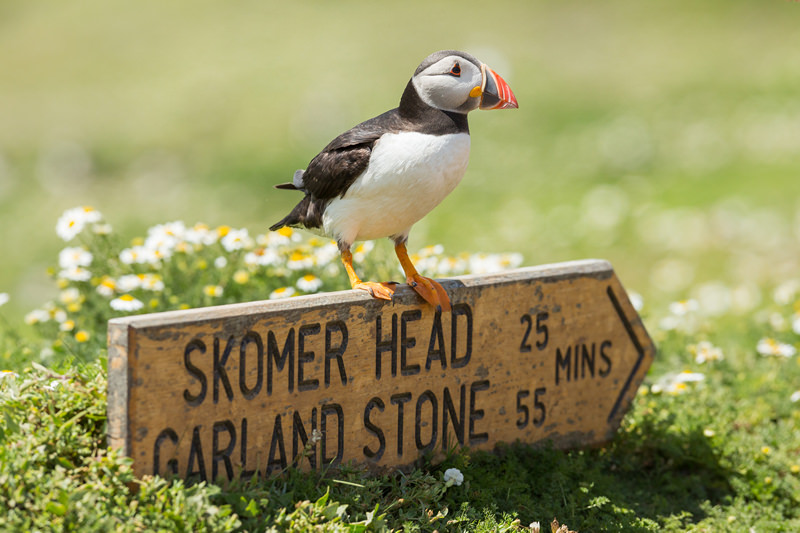
Skomer allows photographers to get closer than ever to birds. All images by Drew Buckley
There's not much in the way of sea to separate Skomer Island from the Pembrokeshire mainland, but it's a world apart when it comes to the richness and diverse wildlife that inhabits this small offshore nature hotspot.
For thousands of years its surrounding seas have protected this wildlife haven. Not only is it the first port of call for many a storm barrelling in from the Atlantic Ocean, but the small stretch of sea which separates the island from the mainland is also extremely treacherous.
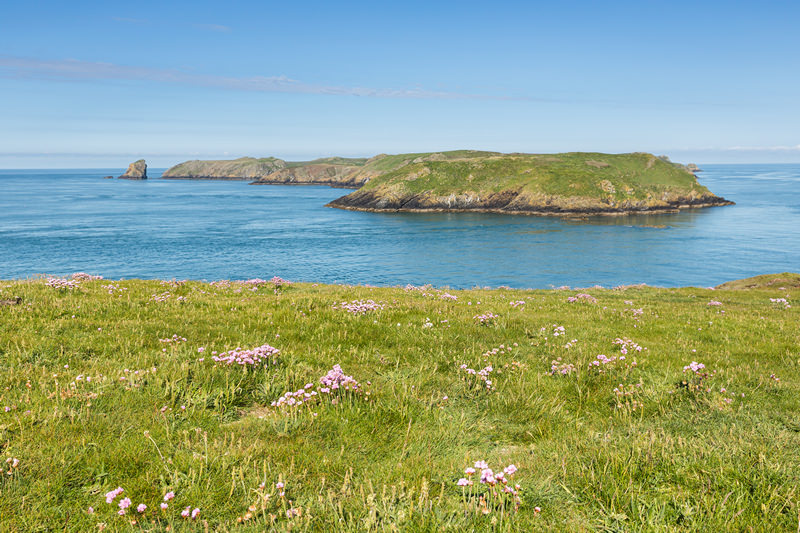
Skomer seen from the mainland
Known as Jack Sound, this 600-metre, rock-strewn, turbulent section of coastal water has a horrid reputation among seafarers. Thankfully, the boat over to the island goes around this, but on a rough day, the seas in St. Brides Bay can still make you queasy.
On Skomer itself is a farm, a barn which has been converted into self-catering accommodation, two bird hides and a few picturesque bays where visiting boats anchor for the night or shelter in rough weather.
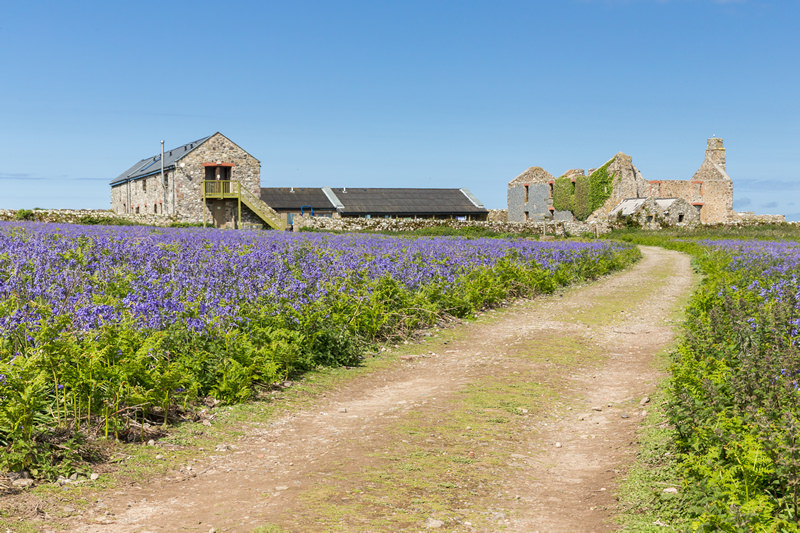
Skomer's farmhouse
Essentially, there's not much to this island, but it more than makes up for it in the abundance of wildlife found here. In the peak of spring and summer, the island comes alive with a vast array of birds and wildflowers. The 730 acres of Skomer provide extremely important breeding grounds for a variety of seabirds, and this has been recognised – the island has been designated a national nature reserve, a site of special scientific interest and a special protection area under European law. Skomer is probably the most important breeding site of Manx shearwaters in the world, with an estimated breeding population of one hundred and sixty five thousand pairs.
I'm sure anyone who's interested in the great outdoors or wildlife in general has heard of this enchanting rocky outcrop on the Pembrokeshire coastline, thanks to its charismatic summer visitor, the puffin. Skomer is home to over six thousand breeding pairs of puffins on Skomer making one of the most important puffin colonies in Britain.
There are many other species of birds and wildlife found on the island, and in this little guide I'll take you on a tour of the island and show you what you’ll find where. Either way, I'm sure you'll have a very memorable visit and capture some amazing views along the way!
Island adventure
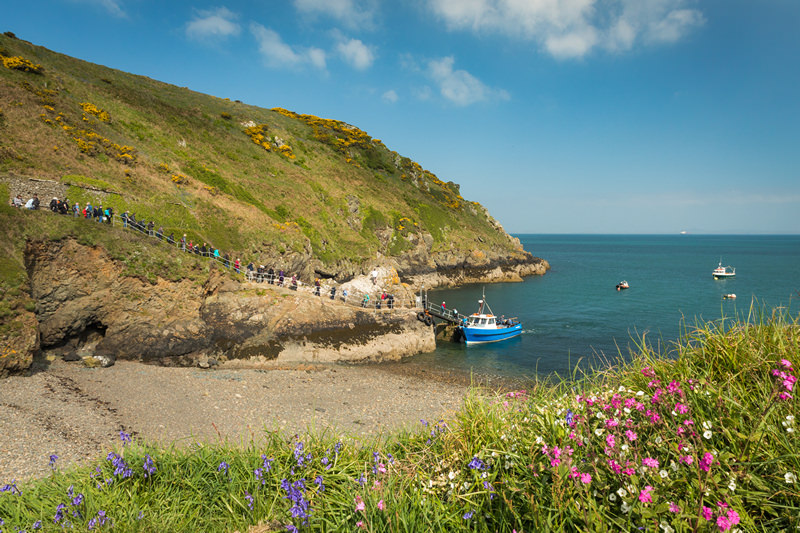
The boat departs from Martin's Haven
You’re finally out in the open water, breathing in the fresh sea air, and the grassy lump that is Skomer Island looms ever closer. On approaching Skomer’s North Haven (where the boat lands) you’ll be greeted by not only the odd gull hitching a lift on the boat cab, but rafts and rafts of puffins, razorbills and guillemots carpeting the water. Here most people start to reach for their cameras in panic, as if these are the only birds they’ll see today. I can assure you, they are not.
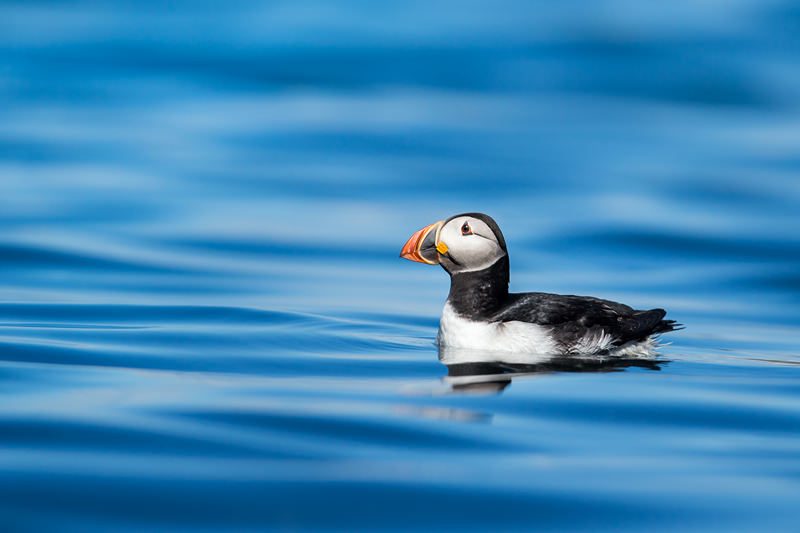
A puffin relaxes on the water
Landing on Skomer and taking the steep (seriously!) steps up to the greeting point, you’ll pass nesting burrows of puffins and razorbills, giving you some very, very up-close views of these beautiful seabirds. It’s funny – with most wildlife photography you’ve never got quite enough lens reach, but with the Skomer seabirds, it’s more the opposite problem!
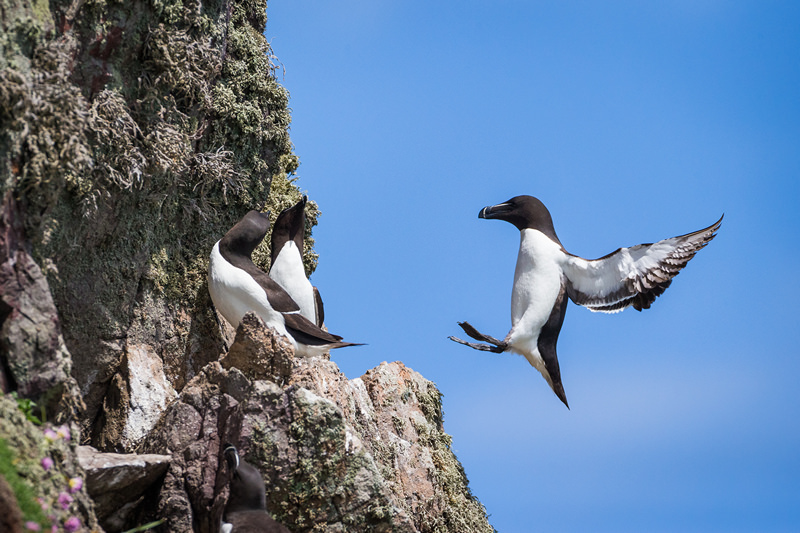
Razorbills
Here, the warden (or one of the great volunteers) will give you a brief talk about the island and explaining what to see, where to see it, where to go, where not to go, and more importantly, where the toilets are!
There are only a few main footpaths on Skomer. From the air, Skomer is oval in shape, with a footpaths running from north to south, west to east and right around the island, with the crossing point in the middle. Here you’ll find the main farm building, toilets, self-catering accommodation and the only shelter on the island if there’s any inclement weather.
It’s suggested to allow around three hours to go round the whole island, covering around four miles of well-maintained paths. You’ll still need a good pair of walking boots, however, as on some parts there are quite a few elevation changes over uneven ground, and some boggy sections.
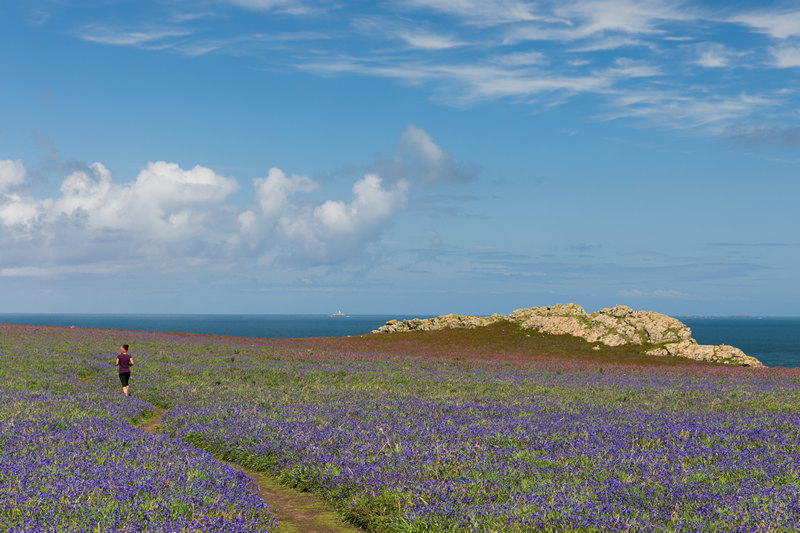
A trail through the bluebells
Heading west straight up the first main path towards the farm, you’ll more than likely encounter noisy nesting oystercatchers protecting their territory from encroaching gulls. Closer towards the farm you’ll get great views of meadow pipits and sedge warblers amongst the ferns. My advice would be to climb up to the trig point and see the whole of the island around you. From here you’ve got three choices. Go north, west or south.
Traveling north from the farm will take you through North Valley. You'll cross the top of an old stone wall showcasing the once farmed extremities of fields. You'll then drop into a snaking path through the bluebells, a spectacular sight and proves that the island was once wooded. Along this stretch are a few pairs of resident short-eared owls and they can be seen flying to and from here and Gorse Hill to the south of the farm. They solely feed on the endemic Skomer vole, a unique subspecies of vole only found on Skomer.
Carrying on north will take you to the top edge of the island, where you’ll find nesting peregrine falcons, puffins and various seabirds. Also, thanks to the nearby rocky outcrop of the Garland Stone, there are some sea currents that stir up the fish here, so there’s a great chance of seeing feeding porpoises and dolphins.
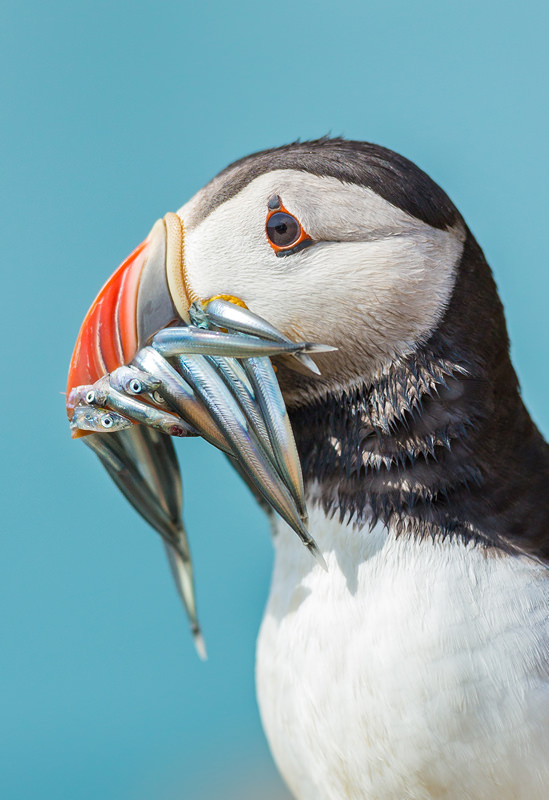
A puffin with the catch of the day
Travelling west will take you past the farm and along a wide open meadow. Keep a keen eye on the stone wall to your left, as this is where the Skomer little owls nest. They’re extremely well camouflaged, and tend to hang around here in the daytime feeding on bugs and small birds.
While here, you’ll notice another island far in the distance: Grassholm Island. From afar this island appears half-white; this is mainly due to the mass of gannets (and their guano) tightly packed onto one small piece of rock. It sits roughly ten miles from the mainland and is a breeding site for nearly forty thousand pairs of gannets and the third largest Atlantic gannetry in the world. With wingspans up to two metres in some cases, these are seriously big birds, and if you're lucky, you'll catch a glimpse of them fishing off Skomer in the surrounding sea to the west and north of the island.
Head to the south west of the island and you’ll arrive at the part everyone comes to see: The Wick. This horseshoe-shaped cliff face is home to Skomer’s six thousand pairs of puffins and also various other seabirds making their homes on the rocky ledges.
The terrain here is completely covered with rabbit burrows, in which the puffins nest, and in peak season the activity in this small section is immense. The sky is filled with birds whirling in circles catching the updrafts from the Irish Sea beneath.
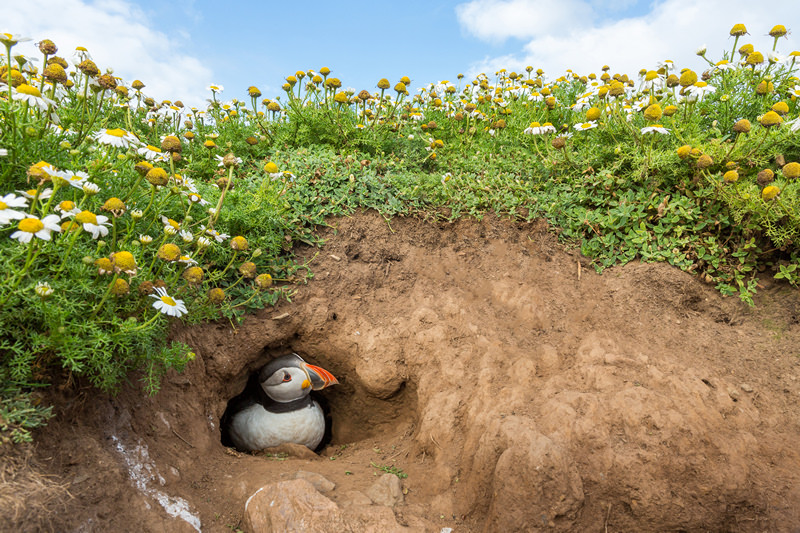
A puffin nests in a burrow
Thankfully there are plenty of places here to stop to admire the view. Puffins land literally feet away from you, diving straight into their burrows, beaks filled to the brim with sand eels, mindful of potential attacks by the hungry great black-backed gulls that try to ambush them on their return.
You won’t be regretting not bring any particular lens with you here, because whatever you have in your bag, you’ll fill the frame with it – they’re that close! There are so many different shots to get here – intimate portraits, close-up details, group shots and my favourite: birds in flight. I’m used to the challenge of tracking birds in flight, but these guys always catch me off-guard with how fast they are! You definitely need time to get your eye in with these seafaring missiles.
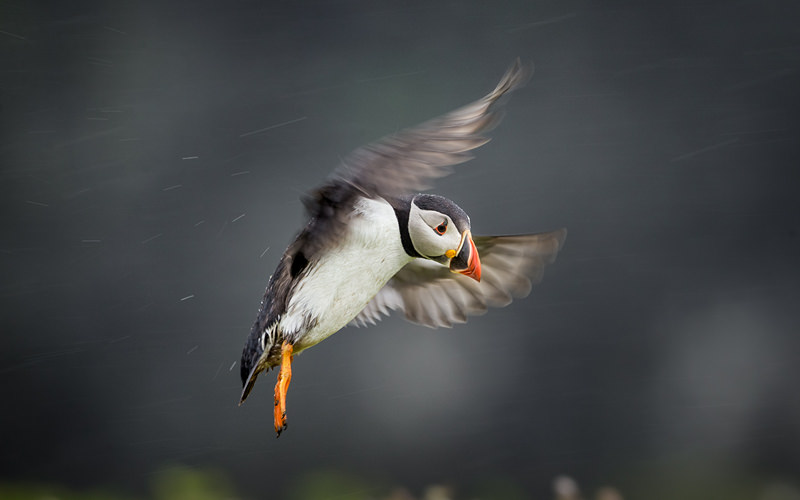
You’ll need good tracking AF!
Heading round to the south of the island you’ll find other species of seabirds nesting on the cliff edges. Kittiwakes, razorbills, guillemots and fulmars all favour this section of the island, and as you can imagine, the noise of all these birds is something to behold. Another offshore rock, the Mew Stone, offers a good place to spot feeding porpoises and dolphins and also grey seals tend to prefer these southern rocky bays all year round.
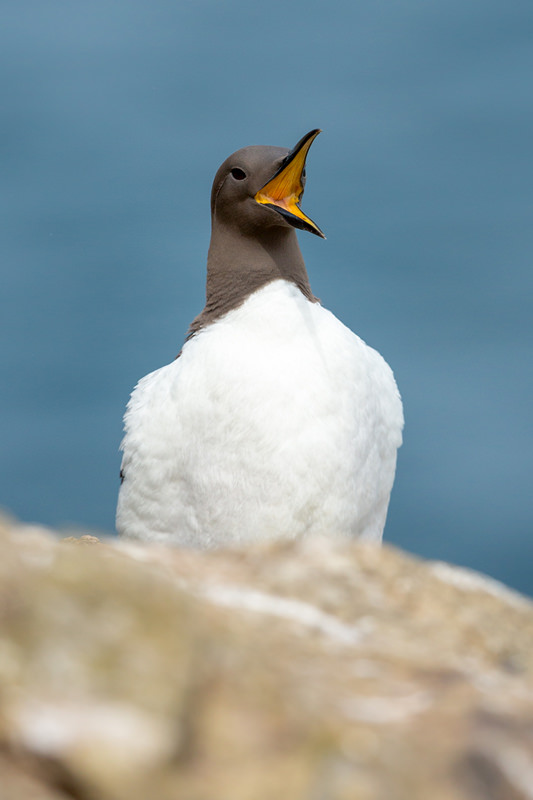
A guillemot
At any part of the island, it would be so easy to just sit and watch, admiring the experience of all this activity in this stunning setting so I’d recommend anyone to stay the night here. Not only do you get to enjoy sunrise and sunset on this magical island but you get more time alone with the landscape and its wildlife without having to be timed for the boat return.
Another major reason Skomer is so important to wildlife is the Manx shearwater. Skomer and neighbouring Skokholm Island holds over one hundred and sixty five thousand pairs of these birds making it one of the most important breeding sites in the world.
They’re well adapted to living at sea, with long, narrow wings and feet placed far back on their bodies for swimming. However, this makes living on land difficult, and the birds tend to be very ungainly on land. This makes them easy prey for predators such as Skomer’s great black-backed gulls, so to counter act this, the birds only leave and return to their nests at night – definitely another big reason to stay the night here is to hear their ghostly calls in the darkness.
Also, you’d be right in guessing Skomer would be a great habitat for grey seals. They’re abundant on Skomer all year round, but particularly August to November, when they haul into the small bays to pup.
There’s no denying that this island is famed for its wildlife but there’s also a vast array of wildflowers that carpet it throughout the spring and summer months. Bluebells cover most parts of the island through April to June, peaking around mid-May, and then combining with freshly flowering red campion. There's also sea campion and thrift, which cover most cliff edges too.
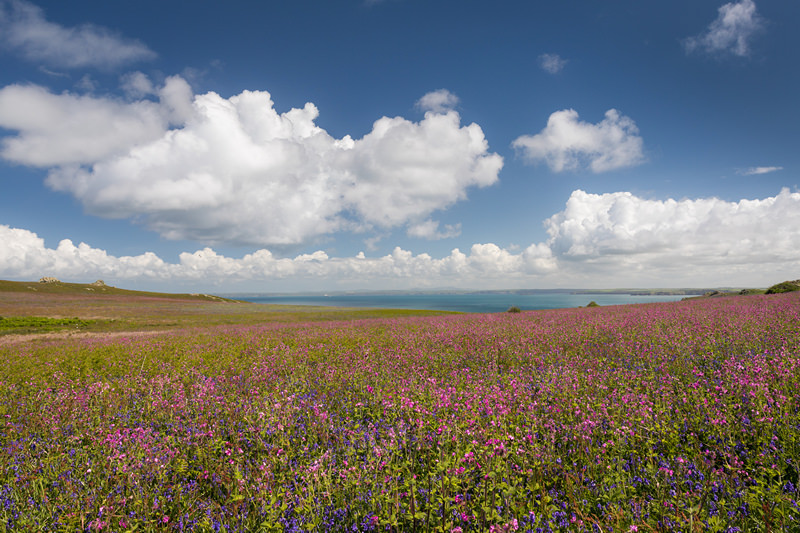
Red campion grows amid the bluebells
As you can see, you really are spoilt for choice on Skomer. I'd recommend anyone to hop on the boat and visit for the day, or even stay over. Either way, I'm sure you'll come away with some fantastic memories and images.
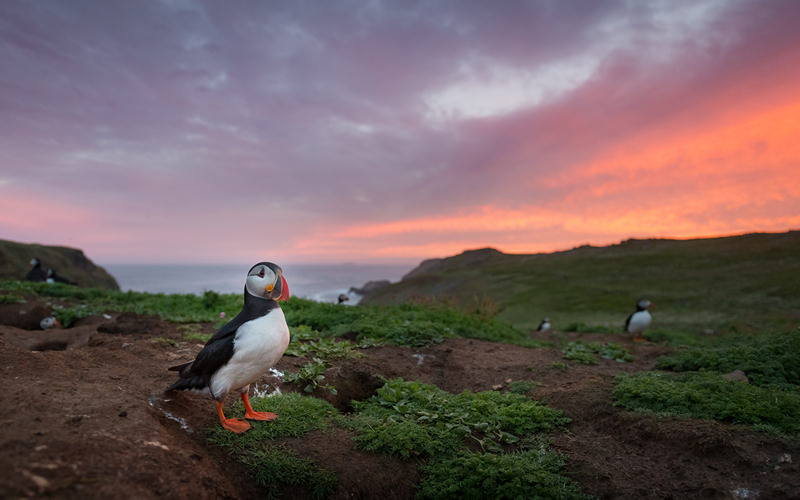
Recommended kit list:
- Camera with decent AF for birds in flight.
- Good mixture of lenses, with a wide-angle for landscapes
- Telephotos for puffins and birds close to the paths
- Longer lenses for owls and birds on cliff edges
- Tripod
- Sturdy walking boots
- Drinks
- Food
- Wet weather gear
- Hat and sun cream
How to get there
From Haverfordwest follow the Dale Road B4327 out west. After 10 miles you'll cross a road bridge over a small river, and then take the next right signposted Marloes/Martins Haven. Head through Marloes village, following the road until you reach its end at Martin's Haven. Park in the National Trust car park (£5 fee or free for members).
Parking lat/long: 51.734736, -5.2435631
Parking postcode: SA62 3BJ
OS map grid ref: SM 761 089
Map: Explorer Map OL 36 (1:25 000) South Pembrokeshire
Accessibility
You'll need to get to the car park early in peak season; I'd aim for 8am so you can park up and head down the hill to queue for landing tickets from the little shop here (landing fee is waived for Wildlife Trust of South and West Wales members) Boats start departing at around 10am, run every hour, and the first return boat is around 3:30pm.
Once you’re ready, head down the steep hill towards the bay, not forgetting to stop off at the toilets on the way – not only to answer the call of nature, but also be greeted with some of the best views of swallows and house martins you’ll ever see, as they nest inside the small building.
The jetty is up and over some steps down onto the boat on an awkward slipway. There are some inclines and declines when landing on the island, including a steep set of steps you’ll encounter when disembarking the boat.
On the island there are about four miles of well-maintained paths; some parts include a few elevation changes over uneven ground and some boggy sections. Other than the tricky matter of embarking and disembarking from the boat, it's generally easy going if you take your time.
Best time of year/day
Undoubtedly late spring is the peak of activity on Skomer, not just for seabirds but wild flowers too! Acres of bluebells carpet the landscape and pathways together with sea thrift around Skomer Head, these flowers fading into red and sea campion in late May before the bracken takes over for the summer at the end of June.
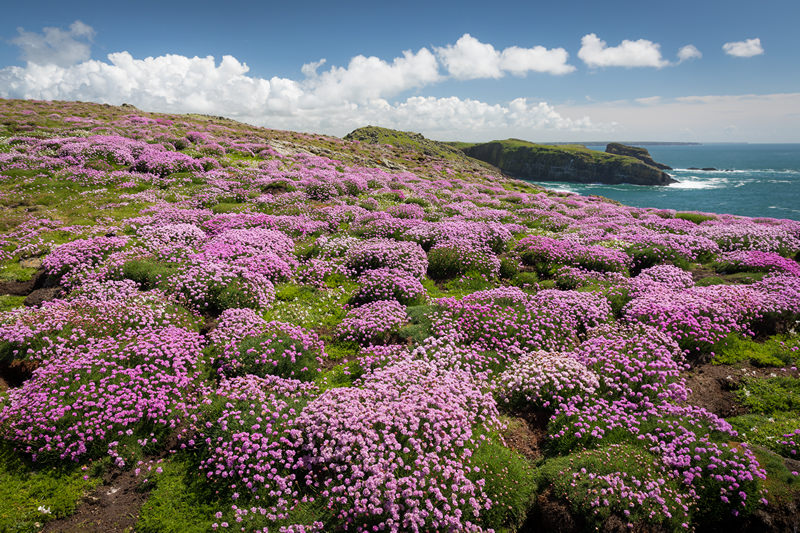
Blooming thrift
The boats sail from April until the end of September, and the island changes appearance and mood throughout the season. The best weather to photograph the seabirds is bright but cloudy, as this helps capture details in both the shadows and highlights (harsh midday sun isn't flattering).
If you can stay over on the island and head to the Wick for sunset, magical light bathes the landscape in golden tones during dawn and dusk, and more birds tend to congregate here right up until sunset.

About the Author
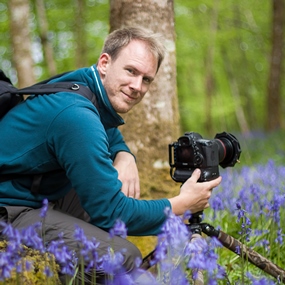
Drew Buckley is a multi-award winning landscape and wildlife photographer based in Pembrokeshire, Wales. He's authored many books and runs his own photography workshops in Pembrokeshire and on Skomer Island in the summer months. Check out the availability calendar on his website to book a workshop. Visit his website, find him on Facebook, and follow him on Twitter.
Related articles
A Photographer’s Guide to the Isle of Skye
How to Photograph Seabirds
Exploring The Isle of Harris

